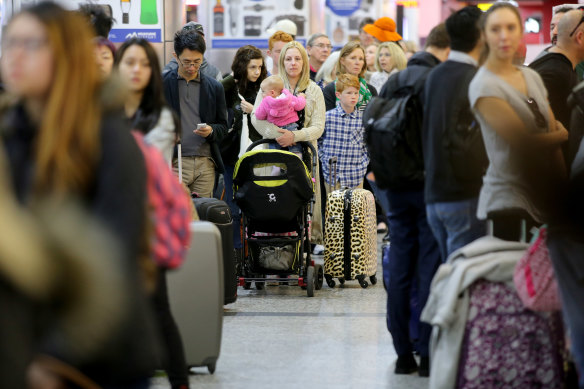Immigration is smashing renters. It’s time to hike fees for international students
Save articles for later
Add articles to your saved list and come back to them any time.
Australia’s rental market is running hot. Slowing migration to take the temperature down, while housing supply catches up, is a smart move. But only if we do it the right way.
Net overseas migration rose to a record high of 454,000 in the year to March and is likely to be more than 500,000 by the end of the year. Migration was always going to surge once Australia’s borders reopened, but it’s run far stronger than anyone imagined.
Immigration numbers have surged since the pandemic, but merely turning off the switch will create more problems.Credit: Wayne Taylor
Every 100,000 extra migrants that we didn’t expect raises rents by about 1 per cent. Those higher rents benefit property owners – and boost national income – but they hurt vulnerable Australians already struggling to pay the rent.
National cabinet’s plan to boost housing supply remains the best way to make housing cheaper in the long term. But building houses takes time, so it won’t solve the immediate rental crisis.
Slowing migration would help vulnerable Australians whose rents are rising today. But if done badly, it would make us all poorer.
Most notably, lowering Australia’s skilled migration intake would be a costly mistake.
Australia is offering 137,100 permanent skilled places this year. Grattan Institute modelling shows that reducing the permanent skilled program by 10,000 places each year could cost the federal and state budgets between $68 billion to $125 billion over the next 30 years. And since most permanent skilled visas go to migrants already in Australia, it would have little impact on migration numbers or rental demand in the short term.
Reducing the number of permanent family visas on offer – 52,500 this year – would also do little to reduce housing demand because applicants would simply remain in Australia for longer on temporary visas while waiting for their permanent visa.
But the current crisis provides an opportunity to scale back the forms of temporary migration that offer the least bang for our population growth buck, while also reducing the number of “permanently temporary” migrants and combatting migrant worker exploitation. It’s a win-win-win.
Here’s what the government should do.
First, it should raise student visa fees, to discourage students intending to complete cheaper, low-value courses from coming to Australia.
International student numbers have surged to 664,000 as universities and other education providers zealously recruit more students, especially in the VET sector.
But many of these students provide little economic benefit to Australia since they pay little in course fees, struggle to find well-paid work once they graduate, and are unlikely to ever secure a permanent skilled visa. Few are studying the skilled trades that we desperately need to build more homes.
Unlike proposals to apply a levy to international student fee revenues, the Home Affairs Minister can raise visa fees with the stroke of a pen, slowing applications for student visas almost immediately.
Raising student visa application fees from $710 to $2500 would raise about $1 billion a year. That would be enough to boost Rent Assistance by 20 per cent, putting another $1000 a year into the pockets of vulnerable renters.
Such a visa fee rise is unlikely to discourage talented students from choosing to study at one of Australia’s top universities – those who we most want to stay permanently – since they already pay upwards of $150,000 for a bachelors’ degree.
Second, the government should lift minimum English standards for international students, keep cracking down on the dodgy providers of low-value courses, and limit visa jumping by students already in Australia by applying a new Genuine Student Test, as recommended in the Parkinson review of the migration system.
Alternative proposals, such as capping the number of international students in Australia, are likely to prove unworkable. For instance, how many international student places would be allocated to each university, and on what basis? And capping student numbers would also raise no extra revenue to help struggling renters.
Third, the government should make it less attractive for struggling students to stay in Australia after they graduate, by offering them shorter post-study work visas. Visa extensions for graduates with degrees in nominated areas of shortage, and for living in the regions, should be scrapped, and visa extensions only offered to those earning at least $70,000 a year. These changes would result in about 140,000 fewer international students and graduates in Australia by 2030 than under current policy.
Fourth, the government should curb the number of working holidaymakers in Australia by abolishing rules that allow them to extend their stay if they work in regional areas. Those rules have been shown to leave migrants vulnerable to exploitation. Instead, working holidaymakers should be limited to a single one-year visa. This change would mean about 25,000 fewer people here on backpacker visas.
The Albanese government has a rare opportunity to make changes that will help struggling renters and improve Australia’s migrant intake. It should act soon.
Brendan Coates and Trent Wiltshire lead the Grattan Institute’s migration policy work.
The Opinion newsletter is a weekly wrap of views that will challenge, champion and inform your own. Sign up here.
Most Viewed in National
From our partners
Source: Read Full Article
